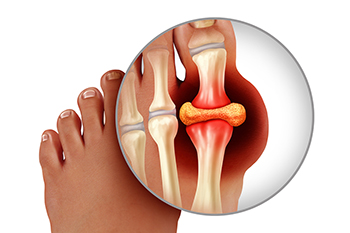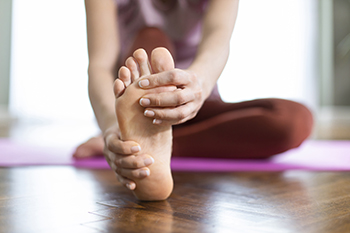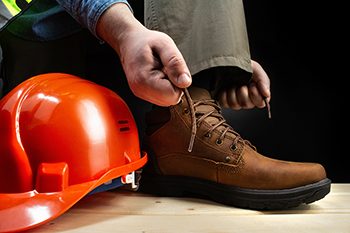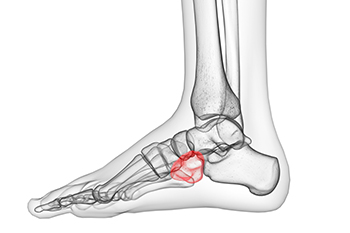Connect With Us
Blog
Items filtered by date: August 2025
Gout and Why It Often Affects the Big Toe

Gout is a form of arthritis caused by a buildup of uric acid crystals in the joints, leading to sudden, severe pain and swelling. It often affects the big toe because this joint is more susceptible to crystal formation due to lower temperatures and high pressure during movement. Causes include high purine intake, dehydration, and reduced kidney function. Risk factors involve genetics, obesity, certain medications, and alcohol consumption. A podiatrist can help by diagnosing the condition, recommending dietary and lifestyle changes, providing pain relief, and offering strategies to prevent future flare ups. If you suspect gout or experience recurring toe pain, it is suggested that you promptly consult a podiatrist who can offer effective relief and management tips for this condition.
Gout is a foot condition that requires certain treatment and care. If you are seeking treatment, contact Melissa C. Verde, DPM from Florida. Our doctor will treat your foot and ankle needs.
What Is Gout?
Gout is a type of arthritis caused by a buildup of uric acid in the bloodstream. It often develops in the foot, especially the big toe area, although it can manifest in other parts of the body as well. Gout can make walking and standing very painful and is especially common in diabetics and the obese.
People typically get gout because of a poor diet. Genetic predisposition is also a factor. The children of parents who have had gout frequently have a chance of developing it themselves.
Gout can easily be identified by redness and inflammation of the big toe and the surrounding areas of the foot. Other symptoms include extreme fatigue, joint pain, and running high fevers. Sometimes corticosteroid drugs can be prescribed to treat gout, but the best way to combat this disease is to get more exercise and eat a better diet.
If you have any questions, please feel free to contact our office located in Longwood, FL . We offer the newest diagnostic and treatment technologies for all your foot care needs.
Various Causes of Toe Pain

Toe pain can come from various conditions, including athlete’s foot, bunions, and ingrown toenails, each with its own causes and symptoms. Athlete’s foot is a fungal infection often caused by sweaty feet and exposure to damp environments, like locker rooms. Athlete’s foot can lead to itching, burning, redness, and peeling skin. Bunions are bony bumps that form at the base of the big toe, often due to genetics, poor footwear, or arthritis, causing pain, swelling, and difficulty walking. Ingrown toenails occur when the edge of a nail grows into the surrounding skin, often from improper trimming or tight shoes. This may lead to pain, redness, swelling, and sometimes infection. Any of these conditions can make walking painful and reduce your quality of life. A podiatrist can diagnose the problem through a physical exam, lab tests, or imaging. Treatments include antifungal medications, orthotics, nail care, or minor procedures to relieve discomfort and correct the issue. If you have toe pain, it is suggested that you schedule an appointment with a podiatrist for appropriate treatment solutions.
Toe pain can disrupt your daily activities. If you have any concerns, contact Melissa C. Verde, DPM of Florida. Our doctor can provide the care you need to keep you pain-free and on your feet.
What Causes Toe Pain?
Most severe toe pain is caused due to a sports injury, trauma from dropping something heavy on the toe, or bumping into something rigid. Other problems can develop over time for various reasons.
Toe pain can be caused by one or more ailments. The most common include:
- Trauma
- Sports injury
- Wearing shoes that are too tight
- Arthritis
- Gout
- Corns and calluses
- Hammertoe
- Bunions
- Blisters
- Ingrown toenails
- Sprains
- Fractures (broken bones)
- Dislocations
When to See a Podiatrist
- Severe pain
- Persistent pain that lasts more than a week
- Signs of infection
- Continued swelling
- Pain that prevents walking
Diagnosis
In many cases the cause of toe pain is obvious, but in others, a podiatrist may want to use more advanced methods to determine the problem. These can range from simple visual inspections and sensation tests to X-rays and MRI scans. Prior medical history, family medical history, and any recent physical traumatic events will all be taken into consideration for a proper diagnosis.
Treatment
Treatments for toe pain and injuries vary and may include shoe inserts, padding, taping, medicines, injections, and in some cases, surgery. If you believe that you have broken a toe, please see a podiatrist as soon as possible.
If you have any questions please contact our office located in Longwood, FL . We offer the newest diagnostic and treatment technologies for all your foot and ankle needs.
Are Bunions Affecting Your Everyday Life?
Protecting Your Feet on the Construction Site

Working in construction exposes your feet to heavy equipment, sharp debris, and uneven surfaces, making foot protection essential. Wearing high-quality steel-toe boots, slip-resistant soles, and cushioned insoles helps prevent injuries, blisters, and long-term strain. Proper hygiene and moisture control are also key to avoiding infections and skin conditions. A podiatrist can evaluate foot pain, provide custom orthotics, and treat injuries to ensure you stay safe and mobile on the job. Ignoring foot discomfort can lead to chronic issues that affect work performance and quality of life. If you have endured a foot injury, it is suggested that you schedule a visit with a podiatrist who can treat various foot conditions, keeping your feet healthy and strong throughout your construction career.
While working on the feet, it is important to take the proper care of them. For more information about working on your feet, contact Melissa C. Verde, DPM from Florida. Our doctor will treat your foot and ankle needs.
Working on Your Feet
Standing on your feet for long periods of time can cause stress and pain in your feet. Your whole body may experience change in terms of posture, back pain, bunions, callouses and or plantar warts. There are ways to avoid these conditions with proper foot care, smart choices and correct posture.
Positive Changes
Negative heeled shoe – Choosing this shoe type places the heel slightly lower than the ball of the foot. These are great for overall foot health. Find shoes that fit you correctly.
Go barefoot – Our feet were not designed to be enclosed for all hours of the day. Try to periodically expose your feet to air.
Eliminate Pain
Foot Exercises – Performing simple exercises, incorporating yoga and doing stretches are beneficial. This will allow increased blood flow to the area and muscles of the foot.
Achilles tendon – Stretching the foot out flat on the floor will relax the calf muscles and tendon. These exercises can be performed almost anywhere. Make sure you add these exercises to your daily regimen.
With a little bit of this information and knowing more about foot health, you will notice changes. Foot stretches and proper footwear will help with pain and prevent further issues.
If you have any questions please contact our office located in Longwood, FL . We offer the newest diagnostic and treatment technologies for all your foot and ankle needs.
Lateral Foot Pain and Cuboid Syndrome

Lateral foot pain refers to discomfort along the outer edge of the foot and may result from overuse, injury, poor foot mechanics, or conditions such as cuboid syndrome. This condition occurs when the cuboid bone is partially dislocated or misaligned, leading to sharp pain, weakness, or instability, especially during weight-bearing activities. Risk factors include ankle sprains, improper footwear, and repetitive stress. A podiatrist can diagnose the exact cause of lateral foot pain, perform necessary adjustments, provide custom orthotics, and recommend stretching and strengthening exercises. If you have persistent outer foot pain, do not ignore the symptoms. It is suggested that you promptly consult a podiatrist who can accurately diagnose and treat cuboid syndrome.
Cuboid syndrome, also known as cuboid subluxation, occurs when the joints and ligaments near the cuboid bone in the foot become torn. If you have cuboid syndrome, consult with Melissa C. Verde, DPM from Florida. Our doctor will assess your condition and provide you with quality foot and ankle treatment.
Cuboid syndrome is a common cause of lateral foot pain, which is pain on the outside of the foot. The condition may happen suddenly due to an ankle sprain, or it may develop slowly overtime from repetitive tension through the bone and surrounding structures.
Causes
The most common causes of cuboid syndrome include:
- Injury – The most common cause of this ailment is an ankle sprain.
- Repetitive Strain – Tension placed through the peroneus longus muscle from repetitive activities such as jumping and running may cause excessive traction on the bone causing it to sublux.
- Altered Foot Biomechanics – Most people suffering from cuboid subluxation have flat feet.
Symptoms
A common symptom of cuboid syndrome is pain along the outside of the foot which can be felt in the ankle and toes. This pain may create walking difficulties and may cause those with the condition to walk with a limp.
Diagnosis
Diagnosis of cuboid syndrome is often difficult, and it is often misdiagnosed. X-rays, MRIs and CT scans often fail to properly show the cuboid subluxation. Although there isn’t a specific test used to diagnose cuboid syndrome, your podiatrist will usually check if pain is felt while pressing firmly on the cuboid bone of your foot.
Treatment
Just as the range of causes varies widely, so do treatments. Some more common treatments are ice therapy, rest, exercise, taping, and orthotics.
If you have any questions, please feel free to contact our office located in Longwood, FL . We offer the newest diagnostic and treatment technologies for all your foot care needs.

